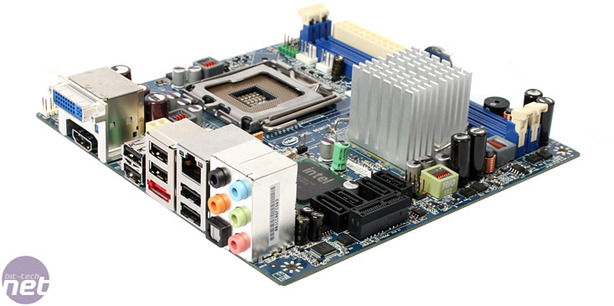
Power Consumption
For Blu-ray playback the G45 uses a bit more power than the Zotac GeForce 9300 board which is not unsurprising given the extra CPU use, although just loading the CPU and memory on its own is in favour of the Intel board, especially if it's left on idling all day doing nothing because it'll save an extra 10W.The reduced power hardware on the DG45FC and more efficient memory controller than Nvidia can both contribute to this.
That said, does 17W constitute to a huge difference in Blu-ray playback load? A poor choice of power supply could leave such low power inefficiency way in excess of this, not to mention a nice stack of hard drives from the four SATA ports adding to the potential load, compared to the Zotac's available two.
Conclusions and Value
Intel has made a mini-ITX board that does the job for a HTPC board - it has an perfect HQV where things like jaggie removal, anti-noise and inverse telecine just work in ClearVideo. With the latest drivers, Intel claims a better HD HQV score, but HD HQV is only important for broadcast material rather than Blu-ray disks and pre-encoded h.264. It also claims better HDMI/HDCP repeater and 24Hz support too which is nice, if not a little late. Again, software is Intel's downfall.
The layout is pretty good and the onboard hardware is as good as the competition from J&W and Zotac, if not in the most directly comparative way (i.e. SATA ports, PCI-Express, memory support etc) but at least this provides consumer choice to nail down exactly what hardware you need.
That's about the limit of what we think is great though. The onboard sound pretty much sucks just like the Zotac, and unless you've no other option or don't care for range and fidelity we recommend avoiding it. The PCI-Express x1 port does offer some upgradeability, but it's short of the J&W's PCIe x4 or the Zotac's full PCIe x16. 65W CPU support is limiting and the BIOS has almost nothing worth writing home about.
The passive heatsinks mean silent computing, which is clearly ideal, however in our opinion the southbridge gets far too hot - over 80°C in an open office only means it'll cook itself inside a small case with limited airflow. The chipsets are glued into place - something reminiscent of the Xbox 360 that stops the package from expanding too far under extreme heat so the tiny solder balls don't crack, killing the board. Why opt for that and not just a larger heatsink for them both? That said, modding your own takes very little effort and it's something we'd encourage.
Generally, the quality of components used is lower than what we're used to from the Taiwanese, but we can't deny that its perfectly adequate for the job at hand.
Final Thoughts
The DG45FC is pretty nifty and pulls some good hardware together, but given a choice we'd buy the Zotac GeForce 9300-ITX, J&W Minix 780G or opt for a micro-ATX G45 motherboard from a popular Taiwanese manufacturer because it'll be more fulfilling for your money. £100 isn't a bad price to pay for a mini-ITX board, but we think the £20 extra for the Zotac or going the AMD route is still a better overall base for a tiny HTPC.- Performance
- x
- x
- x
- x
- x
- x
- x
- x
- -
- -
- 8/10
- Features
- x
- x
- x
- x
- x
- x
- -
- -
- -
- -
- 6/10
- Value
- x
- x
- x
- x
- x
- x
- x
- -
- -
- -
- 7/10
- Overall
- x
- x
- x
- x
- x
- x
- x
- -
- -
- -
- 7/10

MSI MPG Velox 100R Chassis Review
October 14 2021 | 15:04








Want to comment? Please log in.